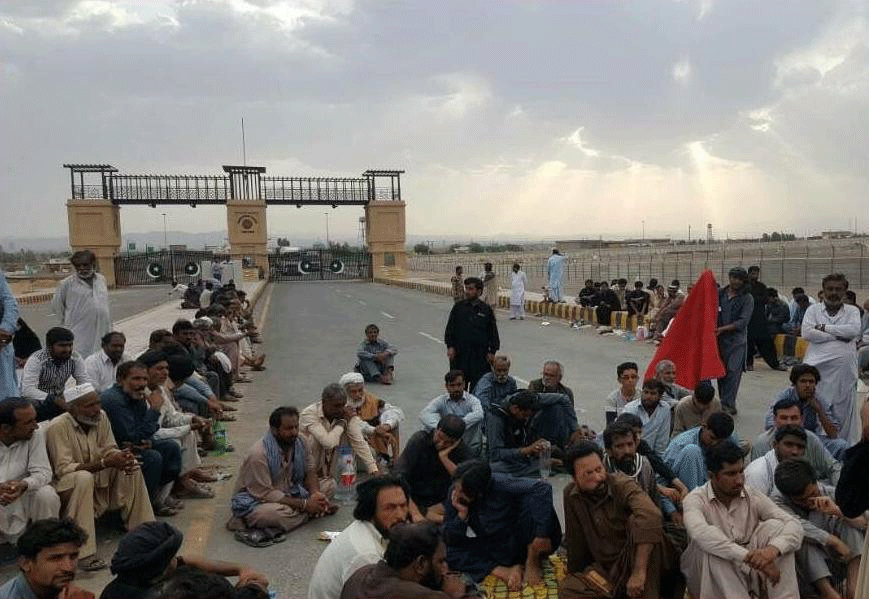Balancing Act
By Muhammad Ismail Khan | Newsbeat International | Published 6 years ago

Brigadier-General Mohammad Pakpour, commander of the Islamic Revolutionary Guard Corps, welcomes four freed Iranian border guards who had been held captive by a militant group in Balochistan.
In the middle of February 2019, in Iran’s southeastern region, bordering Pakistan, a suicide bomber blew himself up. Pakistan condemned the attack, in which 27 personnel of Iran’s Revolutionary Guard were killed. Some Iranian officials indirectly blamed their rivals, while Pakistan offered cooperation.
The attack happened around the time that Saudi Crown Prince, Mohammad Bin Salman, was to visit Pakistan. During the visit, Saudi Deputy Foreign Minister, Abdullah Bin Abdulaziz Al Saud, lashed out at Iran for supporting terrorism. That the statement was made at a press conference on Pakistani soil, in the presence of Pakistan’s Foreign Minister, Shah Mehmood Qureshi, put the country in a diplomatically awkward position. The question on everyone’s mind was whether Pakistan was siding with Saudi Arabia against Iran.
This is not the first time that the two Middle Eastern countries have accused each other of fomenting unrest – and it may not be the last. The two have been at loggerheads since 1979. To the Saudi government, the Iranian revolution has been an anathema, resulting in the spread of Shia ideology in the entire Muslim world. Iran alleges that Saudi-backed Sunni groups have tried to counter that ideology. Ever since the word ‘terrorism’ became popular in the post-9/11 world, the two have been applying the word frequently to one another.
This rivalry between the two has been fought in different parts of the world, including Pakistan’s next-door neighbour, Afghanistan. In the 1990s, Iran was believed to be supporting Shia groups, while the Saudis, the more hardliner Sunni groups. Even today, some observers worry that should the US withdraw from the region in the immediate future, the situation could revert to one that existed in the 1990s, in which Iran and Saudi Arabia competed with one another.
For Pakistan, ties with both countries have their own significance. Iran is Pakistan’s immediate neighbour to the west. In the bordering area, the two share history, an economy, and ties among its people. A section of Pakistani Shias go to Iran for pilgrimage. Moreover, Iran could provide Pakistan a great economic cushion through its energy projects, in particular the Iran-Pakistan pipeline.
At the same time, Pakistan considers Saudi Arabia a friendly country and a saviour of sorts. Saudis have bailed out Pakistan on several occassions, especially during its economic crunches. Consequently, there is a feeling of gratitude towards them. Moreover, a great chunk of our remittances actually comes from the Gulf countries, which include the Saudis and their allies.

Taftan: Pakistani pilgrims at the border crossing between Iran and Pakistan.
Understanding the volatility of the situation and to contain the flames of conflagration, Pakistan projects itself as a neutral player. But this is easier said than done. Since the 1980s, Pakistan has been seen to side with the Saudis. The then president Zia-ul-Haq’s Islamisation programme had rigid Wahabi characteristics and Pakistan and Saudi Arabia backed the same groups in Afghanistan, post the Afghan war. Consequently, the attack in Iran by Sunni extremist groups, including the one in February 2019, is viewed in the same light – the work of regional countries, including Pakistan, colluding against Iran.
But Pakistan needs to chart out certain principles of its foreign policy that keep it at a distance from Saudi-Iran rivalry. It needs to review the binary thinking behind the Middle East conflict: is it really between Iran and Saudi Arabia? One observer noted that while the UAE is a close ally of Saudi Arabia, it is also one of the largest traders with Iran. Moreover, much of Pakistan’s problem emanates from linking Iran with India. One school of thought believes that Iran and India are on the same side, thus making the problem that much more difficult to resolve.
Pakistan must also focus on taking steps to withstand any domestic ripples or repercussions of the Saudi-Iran rivalry, as was seen when the conflict echoed in the country during MBS’s official visit. Even if there is no overt support for either side, the rivalry has the potential to create an environment of agitation within Pakistan. A sizeable section of the country’s Sunni and Shia populations look toward Saudi Arabia and Iran with reverence, making it that much easier for vested interests to stoke the fires of sectarianism.
Pakistan can withstand such pressures only by streamlining its internal voices. Voices absent from decision-making are often the angriest in resistance. The best way to go about this is to engage the Parliament and its various committees that enjoy the support of all segments of society. Pakistan is a diverse country. The internal order should be strong so as to resist any backlash.
One of the areas fast inviting regional attention is the province of Balochistan. On the one hand, it shares a border with Iran, which has deep informal ties with its people. On the other hand, the Arab countries have shown an interest in investing there. When Iran complains of Pakistan’s soil being used by Sunni extremists against it, the reference is obviously towards Balochistan. And although Pakistan’s border with Iran is properly demarcated, there have been some incidents of border violations. On the other side of the political spectrum, Balochistan also faces a nationalist insurgency, elements of which, according to some reports, are known to have escaped to Iran.
Unfortunately, however, Balochistan does not receive extensive coverage in the local media, and so what happens there is reported late. But to avoid getting entangled in any external conflict, Pakistan should ensure that its turf is not being used as a proxy battlefield to its own disadvantage.


